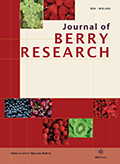Authors: López-Aranda, José M. | Gómez, Francisco | Puga, Martín | Zamora, Ricardo | Daugovish, Oleg | Cotero, Marco A.
Article Type:
Research Article
Abstract:
We evaluated the effectiveness of alternative fumigants on weed control, soil pests, plant growth and marketable roots production in a commercial nursery located at high-elevation and low latitude (Ciudad Guzman, Jalisco) during 2013 and 2014. Treatments were: Methyl bromide with chloropicrin (MB:CP); 1,3-dichloropropene:CP (1,3D:CP); CP alone; metam sodium (MS) alone; dimethyl disulphide with CP (DMDS:CP); and sequentially applied CP and MS (CP+MS). A Rotary Spading Machine was used for MS and CP followed by MS. All treatments except MS and CP+MS in 2014 controlled Rhizoctonia and all controlled Phytophthora in 2013, but none controlled Fusarium in soil.
…No significant nematode, Verticillium and Pythium populations were detected in nursery soil before treatments. No diseased plants were observed throughout the cultivation cycle. Densities and fresh weights of graminoid weeds were significantly reduced by MB:CP and CP+MS, but none of the fumigants controlled all forbs. Only Echinochloa crus-galli , Digitaria spp., Sonchus oleraceus , and Amaranthus hybridus densities and biomass were reduced 50–78% by all fumigants. The highest commercial yield of raspberry roots and plant emergence were recorded with MB:CP and 1,3D:CP, while CP and MS only increased plant emergence. Finally, two years of work on MB alternatives were not sufficient to provide reliable recommendations on this critical need, therefore MBTOC recommended CUN for MB in 2015.
Show more
Keywords: Rubus idaeus, soil disinfestation, plant multiplication, methyl bromide, metam sodium, 1,3-dichloropropene, chloropicrin, dimethyl disulphide, weed control, yields
DOI: 10.3233/JBR-150112
Citation: Journal of Berry Research,
vol. 6, no. 1, pp. 37-46, 2016





